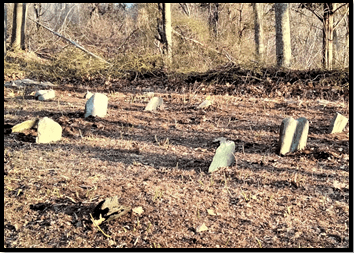Asylum Cemetery
Listen to Audio

The cemetery is roughly 90 feet long by 60 feet wide and contains over 40 burials. The graves date from 1836-1927. They are marked by both headstones and footstones. All markers are uninscribed fieldstones.
The Poor Farm Cemetery is a resting place for all. Here lie the physically disabled, persons with mental health disabilities, the impoverished and the unknown. They were as young as 2 months, and as old as 98 years. Most were white, but a few were Black. At the Asylum/Farm (200 yards to the north) some of the inmates had been chained for long periods. Others were beat and thrown in the dungeon for minor offenses before finally coming here to rest. This cemetery is now a mute reminder of the pain of so many.
On the barren hillside…lay the Potter’s Field, where the paupers who have died at the poor-house lie buried. At the head and foot of each grave is placed a gray slate from the stony hillside, but the slate bears no name nor date. Maude Howe Elliot, 1944
Those same unmarked gravestones can still be seen today. This historic burial ground, now called the Town Farm Cemetery, was tied to the creation of the Portsmouth Asylum in 1833. The Asylum, or Poor Farm, was located 200 feet to the north of the cemetery. The Asylum’s mission was to care for the local poor, with the able-bodied required to work the farm. The ‘inmates’, as they were called, included those that came upon hard times during their lives, persons that had physical disabilities, like William Fales, and individuals that were considered, “insane or deranged”, like Mary Slocum. Some people may even have benefited from this assistance.
However, many long-term residents suffered much pain and trauma from conditions at the Asylum. Some were attacked by other inmates, as when Mary Slocum brutally beat 86-year-old Ann Cornell. Ann died two weeks later. Some were beaten by the staff, such as when the Keeper struck 80-year-old Thomas Durfee in the head with his fist. Others were chained, like William Johnson, a black man sent from Butler hospital in Providence who was described as, “peaceable and inoffensive but that he got in the way”. A few were even locked away in a dungeon, as Mary frequently was. The dungeon was peculiar to Portsmouth. It was finally banned in 1851. Those that died at the Asylum were usually buried in this cemetery, though it was not mandatory. The 10th Rule for governing the Asylum stated in part:
All persons dying at the Asylum, his or her relations or friends may have the liberty of burying them at their own expense; but if at the town’s expense, they may be buried at the Asylum or elsewhere at the discretion of the Commissioners.
There are 76 fieldstone grave markers (headstones & footstones) visible in the cemetery. They represent over 40 burials. The state cemetery database, Rhode Island Historic Cemetery Commission (RIHCC), lists 44 names. The names of 41 people come from the Asylum records of inmates who died there between 1847-1875. Three additional names are included because coffin records show them marked “Town House”. A few did not die at the Asylum, like Elizabeth Casey who was shot by her husband at the coal mines. A few additional names of people that died at the Asylum appear in the Town death records. The final burial was in 1927 for an unknown man.
For some the stay was short, like 2-month-old Lewis Brooks who died after two weeks at the Asylum. Then there was 74-year-old Henrieta Lawton who lived the last 30 years of her life there. Regardless of how long they were there, or if they were oppressors or the oppressed, black or white, they now all lie peacefully together on this quiet hilltop.
